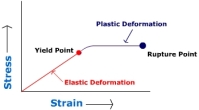15.3: Crustal Deformation
- Page ID
- 16489
Enormous stress is imposed on the crust at the boundaries of the lithospheric plates and where convection currents in the mantle tug and tear at the crust above. When a stress is imposed on rock material it will deform (change shape) and often volume. The change in shape as a result of imposing a stress is called strain.

There are three basic kinds of stress. Compression occurs when rock masses are pushed together like that which occurs when plates collide. Rocks tend to shorten laterally and thicken vertically when exposed to compressional stress. Compression often creates great folds in rock. Tension, or tensional stress, pulls the crust apart, like that which occurs along diverging plate boundaries. Tension extends the crust causing it to thin and lengthen. Rifting, like that which created the Great Rift Valley of Africa, is a result of tension. When plates slide past one another in opposite directions along transform plate boundaries, a shearing stress is created. Shearing stress cuts the crust into parallel blocks displacing them horizontally relative to one another. Shearing takes place along the San Andreas Fault where the Pacific Plate is moving past the North American Plate.
Rocks behave in a variety of ways when stress is imposed on them. The relationship between stress and deformation is shown in stress-strain diagrams like those below. The reaction of rock material to an imposed stress depends on the temperature and pressure conditions. As stress is imposed on rock it starts to deform up to its yield point. Before it gets to the yield point, the rock will undergo elastic deformation (Figure \(\PageIndex{2}\)). Like a rubber band, if the stress is released before reaching the yield point, the rock material will return to its original shape. However, under low temperature and pressure conditions, once the rock reaches its yield point it will break, called brittle failure (Figure \(\PageIndex{3}\)). Brittle failure may occur if stress is imposed suddenly as well.



Upon reaching the yield point under high pressure and temperature conditions, the rock may undergo plastic deformation (Figure \(\PageIndex{4}\)). In this case, once the rock changes shape and if stress is released, it will not return to its original form. During plastic deformation mineral bonds adjust to the stress by breaking, moving about, and then reforming. Once it reaches its rupture point, the material will break.


